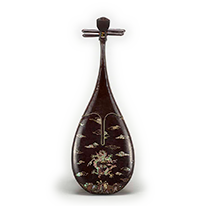Past Exhibitions
- Preserving Lacquers through Conservation
- December 19, 2020 - January 31, 2021
Lacquer (also known as urushi) is derived from the sap of the lacquer tree, which hardens in reaction to the oxygen contained in water particles in the air. Once hardened, lacquer is extremely durable and resistant to high temperatures, acid, salt, and alcohol, though it can deteriorate from exposure to ultraviolet light. The wooden substrates of lacquer objects can also be sensitive to sudden changes in humidity, which can cause expansion and contraction that cracks lacquer coatings. Even when handled with extreme care, lacquers that have been preserved for hundreds of years are prone to damage and can require conservation. For such important historical lacquers, conservators clean the objects and consolidate flaking lacquer and loose mother-of-pearl inlays. They fill or cover losses so that the repairs do not stand out but are still distinguishable from original materials. Conservators also use dilute lacquer to consolidate microcracks on the surfaces while restoring natural luster.












